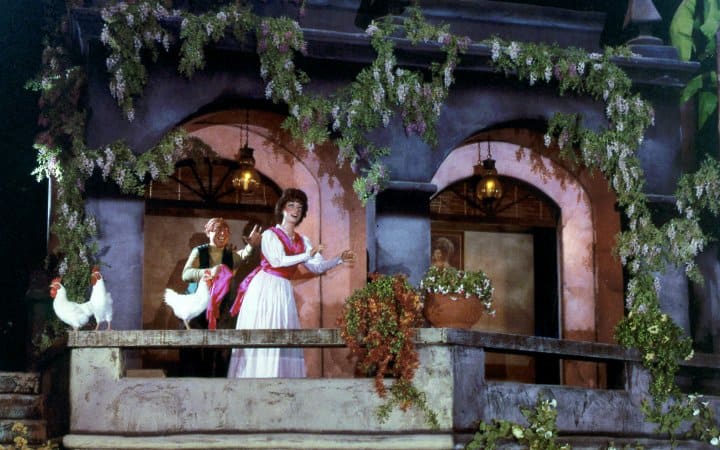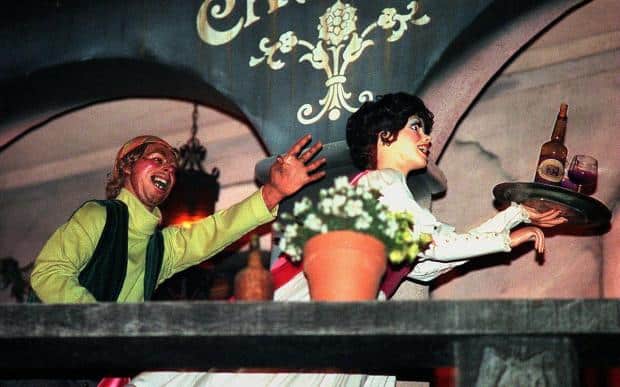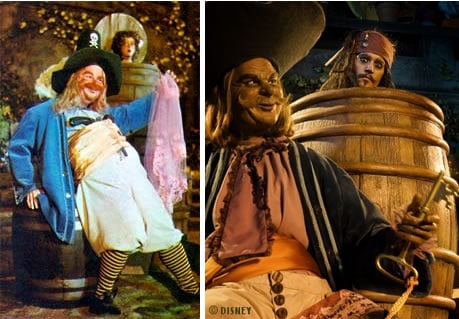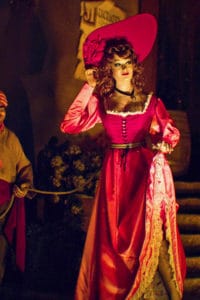“Ye come seekin’ adventure and salty old pirates, eh? Sure, you come to the proper place. But keep a weather eye open, mates, and hold on tight—with both hands, if you please. There be squalls ahead! And Davy Jones waiting for them what don’t obey. And mark well me words, mateys: Dead men tell no tales!”
Anyone who’s been to a Disney theme park will know of its famous attraction “The Pirates of the Caribbean” with the equally famous theme song, “Yo ho, yo ho, a pirate’s life for me.”
This year marks fifty years of sending landlubbers on swashbuckling voyages on the high seas. Originally debuted at Disneyland, California in 1967, “Pirates of the Caribbean” was the last attraction that Walt Disney personally commandeered before his death three months earlier. This attraction was a real game changer in that it raised the standard of what a theme park attraction could and should be. “Pirates” was an elaborate story told through Audio-Animatronics, staged in immersive environments, all viewed from aboard a boat that plunges down (and up) waterfalls.
As a kid, this attraction was a favorite because I could gently cruise through creepy caverns, past thunderstorms and underneath the volleying of cannonballs all from the safety of a very seaworthy vessel. As my boat coasted onward, I’d imagine myself alongside those scalawags as one of them, because for 16 minutes it was okay to (or at least ok to want to) pillage, plunder, rifle, and loot — “Drink up me hearties, yo ho!”
Having been a Disneyland Cast Member (employee of the Walt Disney Company) for a number of years, I can assure you that Disney Parks pride themselves on being able to tell stories and immerse their guests into them like no one else can. The secret to Disneyland’s success is its ability to put you right smack in the middle of those very stories. Take my childhood experience, for example: I became part of the ride, able to to fantasize about a pirate’s life for 16 minutes.
That being said, I learned that it is definitely better to abandon ship. Look more closely at the ride: we see evidence of how the pirates met their demise, whether they are locked up for looting, impaled by swords from a fight over treasure, drunk to death, blown to smithereens, or sitting atop a pile of wealth that they could not take with them. These men who tell no tales all died in vain.
Moral of the story: Yo ho, yo ho a pirate’s life is NOT for you.
***
Over the last half century, “Pirates” has undergone a handful of updates both as social consciousness shifts and in order to keep it fresh and relevant to park guests today. This is a mandate from Captain Walt who promised that as long as imagination is left in the world, Disneyland would continue to grow and change. Three specific changes come to mind:
From Lust to Lush: Throughout the 20th century, public opinion began to change – especially in how we understand gender. Most notably, the original attraction featured some lustful pirates chasing women. While we never did see them catch them, we know what their intentions are. Real life pirates did, in fact, rape women; we’re left to presume that’s what those pirates did too. Over the decades this became a sight that no one wanted to see while they vacation away from the real world at “The Happiest Place on Earth.” This scene has since been reworked to show the pirates chasing the women for the food, treasure and libations they bear.
There was also the “tired pirate (5:10)” who talks about “hoisting his colors on a wench” and how he’s willing to share. Thankfully, his script and role has been changed too as he now monologues about keeping a treasure map and key hidden. I look at these instances now and marvel at how perverted it all seems, and I wonder how this was ever acceptable. Disney did the right thing in changing these scenes, but is exchanging lust for gluttony any better? Just because this type of show was acceptable in the past, it doesn’t make it any less tasteless or anymore okay. It’s good to know that The Walt Disney Company will respond to changes in public opinion. But is that Disney’s primary motivation?
Captain Jack Sparrow Comes Aboard: With the wild success of the attraction-inspired “The Pirates of the Caribbean” movie franchise, Disney infused elements from the films into the existing storyline of the beloved attraction. Take Disney’s newest theme park in Shanghai: it is a far cry from Walt’s original attraction but clearly more spectacular and thrilling. Previously at Disneyland, you would hear a ghostly pirate voice – manifested in the form of a skeletal pirate sitting on a mount of gold – warning us landlubbers as we exit the caverns: “ye’ve seen the cursed treasure, you know where it be hidden. Now proceed at your own risk. Thes be the last ‘friendly’ words ye’ll hear. Ye may not survive to pass this way again.”
Today, however, Disney has seen the cursed treasure that the Pirates franchise brings into the company and thus is choosing to capitalize on using characters such as Captain Jack Sparrow, Captain Barbossa, and Davy Jones. Doing this is a smart move to keep the attraction relevant as a new generation of park goers are no doubt familiar with these films. Thus, instead of the pirates blasting themselves out of the water, the attraction now ends with a very inebriated Captain Jack Sparrow (10:25) gloating about how, for him, a pirate’s life is the pinnacle of success. The moral of the ride seems to be fading away as us landlubbers are left thinking maybe a pirate’s life is for us too.
The “Wench” Auction Scene: Currently, “The Pirates of the Caribbean” features an auction scene where lascivious pirates can bid to “take a wench for a bride.” When I was a kid, I thought it was humorous that a plumpish “wench” was eager to show her “larboard side” and “superstructure” in the hopes of bagging a pirate.
My favorite “wench” in the auction scene is “the redhead.” She is beautiful and she shamelessly flaunts her beauty as the onlooking pirates across the way give cat calls and shout “We wants the redhead.” I guess that growing up, I didn’t really think about what the pirates wanted to do with the sexy redhead. Later as a Cast Member, one of my favorite co-workers was a redhead. Still without really thinking about what those pirates meant, I could be heard calling out to my redheaded leader “We wants the redhead!”
How did we ever think that this jovial display of sex trafficking was ever ok? Do gender expectations and lack of financial resources lead her to think that the only way to get a husband is to put herself up for auction? This is just in poor taste on Disney’s part. And while we can easily shift blame to a previous generation, I too am responsible for promoting this culture when I cat-called back to my red-headed co-worker.
Disney has now decided to alter this scene because let’s face it, sex trafficking shouldn’t be funny or taken lightly. This is clearly a good thing. I applaud Disney for stopping the promotion of sex trafficking or, for that matter, any abuse of women.
As the re-imaged story goes, the redhead becomes the first female pirate. She and the other women are no longer up for auction. Now she stands with rifle in tow, assisting with the auctioning of the goods that the townspeople seem forced to bring over. Instead of shamelessly flaunting her beauty, she now shamelessly exploits people for their goods at gunpoint.
***
But is this latest change actually all that good? While Disney put an end to selling off women, I have to wonder if making the redhead a pirate was the right thing to do. Can women really be proud that they are now represented as pirates? Does changing the auctioning of women for the auctioning of stolen goods make it that much better?
I will always love Disneyland, the “Pirates of the Caribbean” attraction, and I applaud Disney’s efforts in rolling with the tide of public opinion. But what is left in the process? Has Disney lost the idea that a pirate’s life is a bad thing, especially in these last two changes? Is it okay to promote pirate values as long as the films make money? By giving Disney guests the first female pirate, and by phasing out the moral of the attraction does it mean that the American public thinks it’s okay to “pillage, plunder, rifle and loot? Drink up me hearties, yo-ho”?
-//-
Cover image courtesy Orange County Register.






